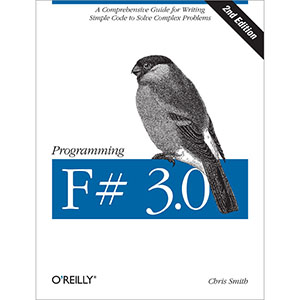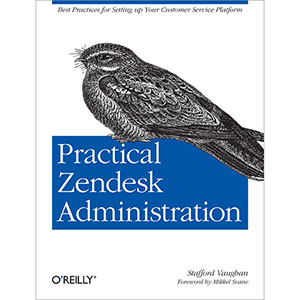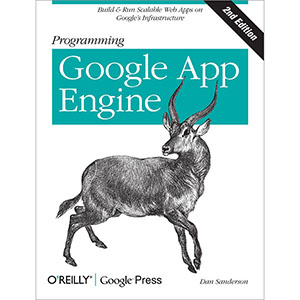| Python for Data Analysis Posted: 29 Oct 2012 03:02 AM PDT 
Book Description Python for Data Analysis is concerned with the nuts and bolts of manipulating, processing, cleaning, and crunching data in Python. It is also a practical, modern introduction to scientific computing in Python, tailored for data-intensive applications. This is a book about the parts of the Python language and libraries you'll need to effectively solve a broad set of data analysis problems. This book is not an exposition on analytical methods using Python as the implementation language. Written by Wes McKinney, the main author of the pandas library, this hands-on book is packed with practical cases studies. It's ideal for analysts new to Python and for Python programmers new to scientific computing. - Use the IPython interactive shell as your primary development environment
- Learn basic and advanced NumPy (Numerical Python) features
- Get started with data analysis tools in the pandas library
- Use high-performance tools to load, clean, transform, merge, and reshape data
- Create scatter plots and static or interactive visualizations with matplotlib
- Apply the pandas groupby facility to slice, dice, and summarize datasets
- Measure data by points in time, whether it's specific instances, fixed periods, or intervals
- Learn how to solve problems in web analytics, social sciences, finance, and economics, through detailed examples
Table of Contents
Chapter 1. Preliminaries
Chapter 2. Introductory Examples
Chapter 3. IPython: An Interactive Computing and Development Environment
Chapter 4. NumPy Basics: Arrays and Vectorized Computation
Chapter 5. Getting Started with pandas
Chapter 6. Data Loading, Storage, and File Formats
Chapter 7. Data Wrangling: Clean, Transform, Merge, Reshape
Chapter 8. Plotting and Visualization
Chapter 9. Data Aggregation and Group Operations
Chapter 10. Time Series
Chapter 11. Financial and Economic Data Applications
Chapter 12. Advanced NumPy Book Details - Paperback: 470 pages
- Publisher: O’Reilly Media (October 2012)
- Language: English
- ISBN-10: 1449319793
- ISBN-13: 978-1449319793
Note: There is a file embedded within this post, please visit this post to download the file. Related Posts The post Python for Data Analysis appeared first on Wow! eBook - Blog. 

|
| Natural Language Annotation for Machine Learning Posted: 29 Oct 2012 02:56 AM PDT 
Book Description Create your own natural language training corpus for machine learning. Whether you're working with English, Chinese, or any other natural language, this hands-on book guides you through a proven annotation development cycle—the process of adding metadata to your training corpus to help ML algorithms work more efficiently. You don't need any programming or linguistics experience to get started. Using detailed examples at every step, you'll learn how the MATTER Annotation Development Process helps you Model, Annotate, Train, Test, Evaluate, and Revise your training corpus. You also get a complete walkthrough of a real-world annotation project. - Define a clear annotation goal before collecting your dataset (corpus)
- Learn tools for analyzing the linguistic content of your corpus
- Build a model and specification for your annotation project
- Examine the different annotation formats, from basic XML to the Linguistic Annotation Framework
- Create a gold standard corpus that can be used to train and test ML algorithms
- Select the ML algorithms that will process your annotated data
- Evaluate the test results and revise your annotation task
- Learn how to use lightweight software for annotating texts and adjudicating the annotations
This book is a perfect companion to O'Reilly's Natural Language Processing with Python. Table of Contents
Chapter 1. The Basics
Chapter 2. Defining Your Goal and Dataset
Chapter 3. Corpus Analytics
Chapter 4. Building Your Model and Specification
Chapter 5. Applying and Adopting Annotation Standards
Chapter 6. Annotation and Adjudication
Chapter 7. Training: Machine Learning
Chapter 8. Testing and Evaluation
Chapter 9. Revising and Reporting
Chapter 10. Annotation: TimeML
Chapter 11. Automatic Annotation: Generating TimeML
Chapter 12. Afterword: The Future of Annotation Appendix A. List of Available Corpora and Specifications
Appendix B. List of Software Resources
Appendix C. MAE User Guide
Appendix D. MAI User Guide
Appendix E. Bibliography Book Details - Paperback: 344 pages
- Publisher: O’Reilly Media (October 2012)
- Language: English
- ISBN-10: 1449306667
- ISBN-13: 978-1449306663
Note: There is a file embedded within this post, please visit this post to download the file. Related Posts The post Natural Language Annotation for Machine Learning appeared first on Wow! eBook - Blog. 

|
| Programming F# 3.0, 2nd Edition Posted: 29 Oct 2012 02:50 AM PDT 
Book Description Why learn F#? With this guide, you'll learn how this multi-paradigm language not only offers you an enormous productivity boost through functional programming, but also lets you develop applications using your existing object-oriented and imperative programming skills. You'll quickly discover the many advantages of the language, including access to all the great tools and libraries of the .NET platform. Reap the benefits of functional programming for your next project, whether you're writing concurrent code, or building data- or math-intensive applications. With this comprehensive book, former F# team member Chris Smith gives you a head start on the fundamentals and walks you through advanced concepts of the F# language. - Learn F#'s unique characteristics for building applications
- Gain a solid understanding of F#'s core syntax, including object-oriented and imperative styles
- Make your object-oriented code better by applying functional programming patterns
- Use advanced functional techniques, such as tail-recursion and computation expressions
- Take advantage of multi-core processors with asynchronous workflows and parallel programming
- Use new type providers for interacting with web services and information-rich environments
- Learn how well F# works as a scripting language
Table of Contents
Part I: Multiparadigm Programming
Chapter 1. Introduction to F#
Chapter 2. Fundamentals
Chapter 3. Functional Programming
Chapter 4. Imperative Programming
Chapter 5. Object-Oriented Programming
Chapter 6. .NET Programming Part II: Programming F#
Chapter 7. Applied Functional Programming
Chapter 8. Applied Object-Oriented Programming
Chapter 9. Asynchronous and Parallel Programming
Chapter 10. Scripting
Chapter 11. Data Processing Part III: Extending the F# Language
Chapter 12. Reflection
Chapter 13. Computation Expressions
Chapter 14. Quotations
Chapter 15. Type Providers Part IV: Appendixes
Appendix A. Overview of .NET Libraries
Appendix B. F# Interop Book Details - Paperback: 474 pages
- Publisher: O’Reilly Media; 2nd Edition (October 2012)
- Language: English
- ISBN-10: 1449320295
- ISBN-13: 978-1449320294
Note: There is a file embedded within this post, please visit this post to download the file. Related Posts The post Programming F# 3.0, 2nd Edition appeared first on Wow! eBook - Blog. 

|
| Practical Zendesk Administration Posted: 29 Oct 2012 02:44 AM PDT 
Book Description Implementing Zendesk as part of your company's operations can be a time-consuming process. In this hands-on guide, author Stafford Vaughan provides the most comprehensive set of best practices for setting up and using Zendesk, distilled from years of training companies how to launch this popular customer service software. You'll learn the purpose, benefits, and pitfalls of each Zendesk feature, with examples of how you can configure it to match your company's needs and processes. Through several real-world examples, you'll also discover how other companies use the product, so you can determine how best to put Zendesk's potential into practice for your business. - Customize your Zendesk customer service tool with your brand
- Create tickets using email, voice, chat, feedback tabs, and social media
- Implement security measures, including ways to safely login from social media sites
- Generate profiles and permissions for your Zendesk customers, agents, and administrators
- Understand the data capture lifecycle, and control the fields your customers are required to fill out
- Apply techniques for making your agent process more efficient
- Modify Zendesk to reflect your existing customer service process
- Use forums to provide self-service support for your customers
Table of Contents
Chapter 1. Introduction to Zendesk
Chapter 2. Initial Setup
Chapter 3. Security
Chapter 4. User Management
Chapter 5. Channels
Chapter 6. Fields and Data Capture
Chapter 7. Agent Support Process
Chapter 8. Automated Business Rules
Chapter 9. Forums Book Details - Paperback: 190 pages
- Publisher: O’Reilly Media (October 2012)
- Language: English
- ISBN-10: 1449343643
- ISBN-13: 978-1449343644
Note: There is a file embedded within this post, please visit this post to download the file. Related Posts The post Practical Zendesk Administration appeared first on Wow! eBook - Blog. 

|
| Programming Google App Engine, 2nd Edition Posted: 29 Oct 2012 02:38 AM PDT 
Book Description Google App Engine makes it easy to create a web application that can serve millions of people as easily as serving hundreds, with minimal up-front investment. With Programming Google App Engine, Google engineer Dan Sanderson provides practical guidance for designing and developing your application on Google's vast infrastructure, using App Engine's scalable services and simple development model. Through clear and concise instructions, you'll learn how to get the most out of App Engine's nearly unlimited computing power. This second edition is fully updated and expanded to cover Python 2.7 and Java 6 support, multithreading, asynchronous service APIs, and the use of frameworks such as Django 1.3 and webapp2. - Understand how App Engine handles web requests and executes application code
- Learn about new datastore features for queries and indexes, transactions, and data modeling
- Create, manipulate, and serve large data files with the Blobstore
- Use task queues to parallelize and distribute computation across the infrastructure
- Employ scalable services for email, instant messaging, and communicating with web services
- Track resource consumption, and optimize your application for speed and cost effectiveness
Table of Contents
Chapter 1. Introducing Google App Engine
Chapter 2. Creating an Application
Chapter 3. Configuring an Application
Chapter 4. Request Handlers and Instances
Chapter 5. Datastore Entities
Chapter 6. Datastore Queries
Chapter 7. Datastore Transactions
Chapter 8. Datastore Administration
Chapter 9. Data Modeling with Python
Chapter 10. The Java Persistence API
Chapter 11. The Memory Cache
Chapter 12. Large Data and the Blobstore
Chapter 13. Fetching URLs and Web Resources
Chapter 14. Sending and Receiving Email Messages
Chapter 15. Sending and Receiving Instant Messages with XMPP
Chapter 16. Task Queues and Scheduled Tasks
Chapter 17. Optimizing Service Calls
Chapter 18. The Django Web Application Framework
Chapter 19. Managing Request Logs
Chapter 20. Deploying and Managing Applications Book Details - Paperback: 536 pages
- Publisher: O’Reilly Media / Google Press; 2nd Edition (October 2012)
- Language: English
- ISBN-10: 144939826X
- ISBN-13: 978-1449398262
Note: There is a file embedded within this post, please visit this post to download the file. Related Posts The post Programming Google App Engine, 2nd Edition appeared first on Wow! eBook - Blog. 

|







Tidak ada komentar:
Posting Komentar